Business Environment Analysis of Fulton’s Foods in the UK
VerifiedAdded on 2024/05/21
|20
|5258
|418
Report
AI Summary
This report provides a comprehensive analysis of the business environment, focusing on the UK supermarket sector, with Fulton’s Foods as a case study. It begins by defining the business environment and differentiating between micro and macro factors, highlighting their impact on organizational strategies. The report explores various types of organizations, including public, private, and voluntary sectors, detailing their structures, sizes, and scopes. An examination of organizational structures, such as functional, divisional, matrix, and flat structures, is provided with a detailed overview of Fulton's Foods' organizational structure and functions. The report then employs the PESTLE model to identify positive and negative impacts of the macro environment on the UK retail sector, followed by internal SWOT and external Five Forces model analyses to pinpoint the strengths and weaknesses of a UK supermarket. The interrelation between these strengths and weaknesses with external macro factors is also explained, concluding with a summary of the key findings and implications for business strategy.

BUSINESS ENVIRONMENT
Paraphrase This Document
Need a fresh take? Get an instant paraphrase of this document with our AI Paraphraser
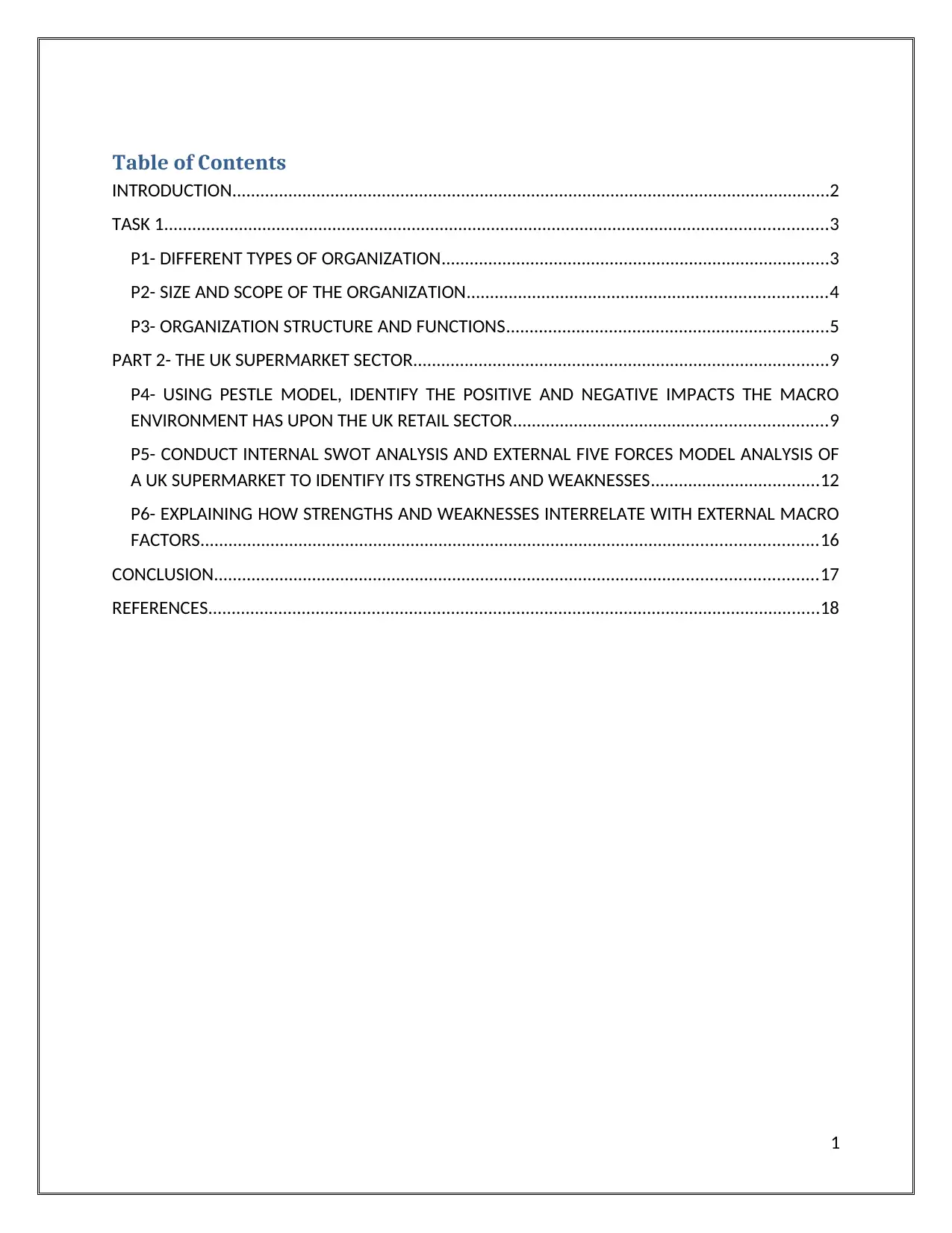
Table of Contents
INTRODUCTION................................................................................................................................2
TASK 1..............................................................................................................................................3
P1- DIFFERENT TYPES OF ORGANIZATION...................................................................................3
P2- SIZE AND SCOPE OF THE ORGANIZATION.............................................................................4
P3- ORGANIZATION STRUCTURE AND FUNCTIONS.....................................................................5
PART 2- THE UK SUPERMARKET SECTOR.........................................................................................9
P4- USING PESTLE MODEL, IDENTIFY THE POSITIVE AND NEGATIVE IMPACTS THE MACRO
ENVIRONMENT HAS UPON THE UK RETAIL SECTOR...................................................................9
P5- CONDUCT INTERNAL SWOT ANALYSIS AND EXTERNAL FIVE FORCES MODEL ANALYSIS OF
A UK SUPERMARKET TO IDENTIFY ITS STRENGTHS AND WEAKNESSES....................................12
P6- EXPLAINING HOW STRENGTHS AND WEAKNESSES INTERRELATE WITH EXTERNAL MACRO
FACTORS....................................................................................................................................16
CONCLUSION.................................................................................................................................17
REFERENCES...................................................................................................................................18
1
INTRODUCTION................................................................................................................................2
TASK 1..............................................................................................................................................3
P1- DIFFERENT TYPES OF ORGANIZATION...................................................................................3
P2- SIZE AND SCOPE OF THE ORGANIZATION.............................................................................4
P3- ORGANIZATION STRUCTURE AND FUNCTIONS.....................................................................5
PART 2- THE UK SUPERMARKET SECTOR.........................................................................................9
P4- USING PESTLE MODEL, IDENTIFY THE POSITIVE AND NEGATIVE IMPACTS THE MACRO
ENVIRONMENT HAS UPON THE UK RETAIL SECTOR...................................................................9
P5- CONDUCT INTERNAL SWOT ANALYSIS AND EXTERNAL FIVE FORCES MODEL ANALYSIS OF
A UK SUPERMARKET TO IDENTIFY ITS STRENGTHS AND WEAKNESSES....................................12
P6- EXPLAINING HOW STRENGTHS AND WEAKNESSES INTERRELATE WITH EXTERNAL MACRO
FACTORS....................................................................................................................................16
CONCLUSION.................................................................................................................................17
REFERENCES...................................................................................................................................18
1
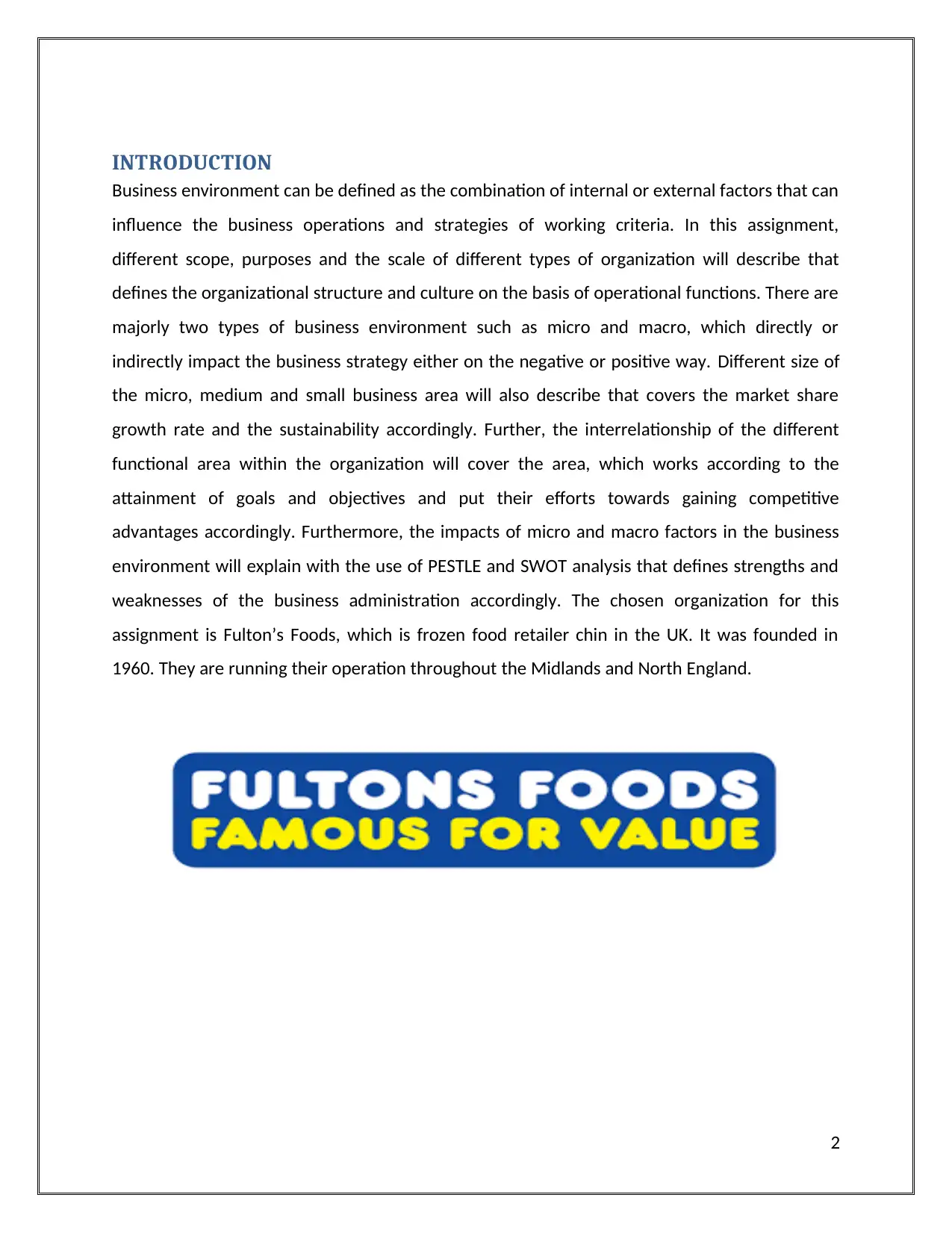
INTRODUCTION
Business environment can be defined as the combination of internal or external factors that can
influence the business operations and strategies of working criteria. In this assignment,
different scope, purposes and the scale of different types of organization will describe that
defines the organizational structure and culture on the basis of operational functions. There are
majorly two types of business environment such as micro and macro, which directly or
indirectly impact the business strategy either on the negative or positive way. Different size of
the micro, medium and small business area will also describe that covers the market share
growth rate and the sustainability accordingly. Further, the interrelationship of the different
functional area within the organization will cover the area, which works according to the
attainment of goals and objectives and put their efforts towards gaining competitive
advantages accordingly. Furthermore, the impacts of micro and macro factors in the business
environment will explain with the use of PESTLE and SWOT analysis that defines strengths and
weaknesses of the business administration accordingly. The chosen organization for this
assignment is Fulton’s Foods, which is frozen food retailer chin in the UK. It was founded in
1960. They are running their operation throughout the Midlands and North England.
2
Business environment can be defined as the combination of internal or external factors that can
influence the business operations and strategies of working criteria. In this assignment,
different scope, purposes and the scale of different types of organization will describe that
defines the organizational structure and culture on the basis of operational functions. There are
majorly two types of business environment such as micro and macro, which directly or
indirectly impact the business strategy either on the negative or positive way. Different size of
the micro, medium and small business area will also describe that covers the market share
growth rate and the sustainability accordingly. Further, the interrelationship of the different
functional area within the organization will cover the area, which works according to the
attainment of goals and objectives and put their efforts towards gaining competitive
advantages accordingly. Furthermore, the impacts of micro and macro factors in the business
environment will explain with the use of PESTLE and SWOT analysis that defines strengths and
weaknesses of the business administration accordingly. The chosen organization for this
assignment is Fulton’s Foods, which is frozen food retailer chin in the UK. It was founded in
1960. They are running their operation throughout the Midlands and North England.
2
⊘ This is a preview!⊘
Do you want full access?
Subscribe today to unlock all pages.

Trusted by 1+ million students worldwide
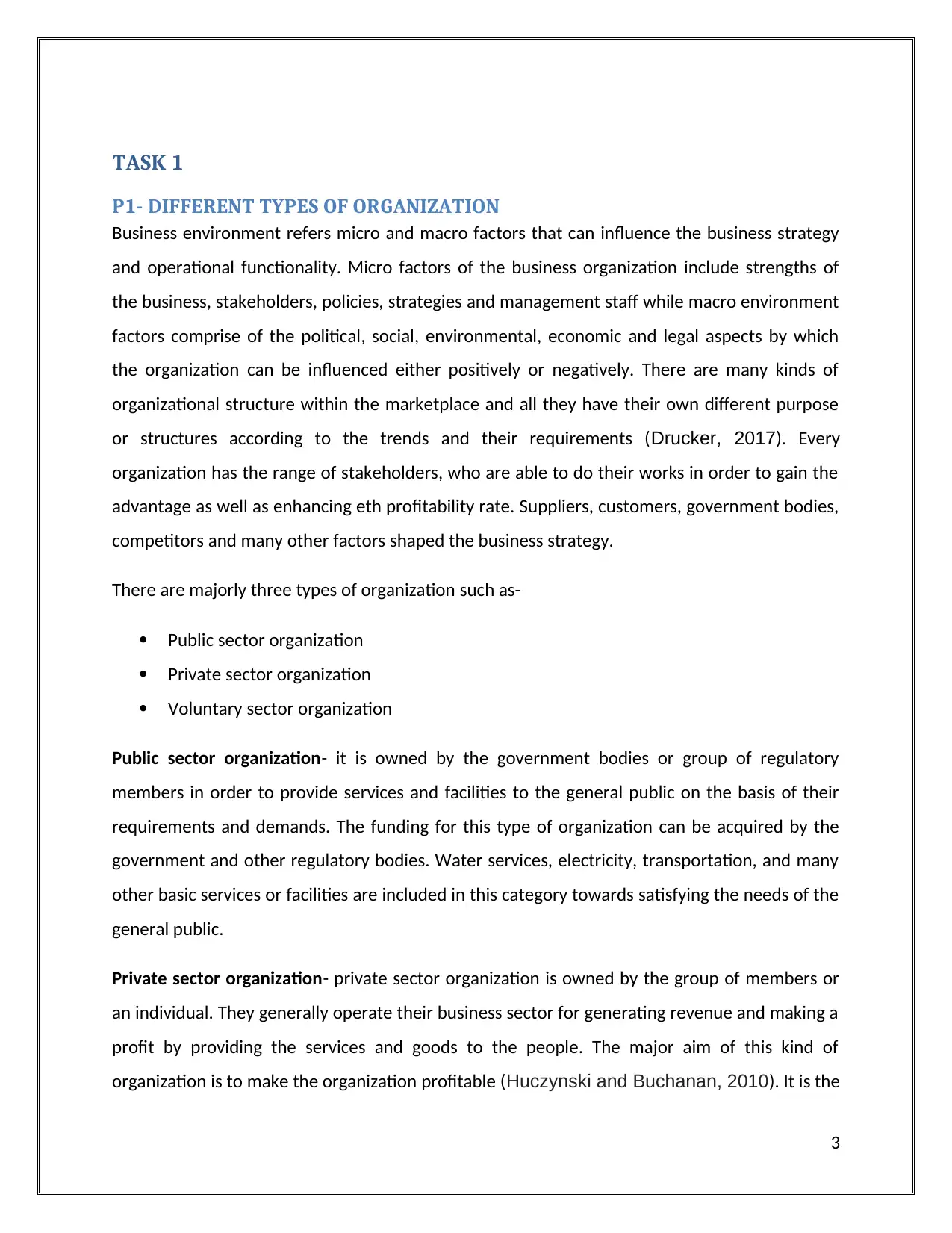
TASK 1
P1- DIFFERENT TYPES OF ORGANIZATION
Business environment refers micro and macro factors that can influence the business strategy
and operational functionality. Micro factors of the business organization include strengths of
the business, stakeholders, policies, strategies and management staff while macro environment
factors comprise of the political, social, environmental, economic and legal aspects by which
the organization can be influenced either positively or negatively. There are many kinds of
organizational structure within the marketplace and all they have their own different purpose
or structures according to the trends and their requirements (Drucker, 2017). Every
organization has the range of stakeholders, who are able to do their works in order to gain the
advantage as well as enhancing eth profitability rate. Suppliers, customers, government bodies,
competitors and many other factors shaped the business strategy.
There are majorly three types of organization such as-
Public sector organization
Private sector organization
Voluntary sector organization
Public sector organization- it is owned by the government bodies or group of regulatory
members in order to provide services and facilities to the general public on the basis of their
requirements and demands. The funding for this type of organization can be acquired by the
government and other regulatory bodies. Water services, electricity, transportation, and many
other basic services or facilities are included in this category towards satisfying the needs of the
general public.
Private sector organization- private sector organization is owned by the group of members or
an individual. They generally operate their business sector for generating revenue and making a
profit by providing the services and goods to the people. The major aim of this kind of
organization is to make the organization profitable (Huczynski and Buchanan, 2010). It is the
3
P1- DIFFERENT TYPES OF ORGANIZATION
Business environment refers micro and macro factors that can influence the business strategy
and operational functionality. Micro factors of the business organization include strengths of
the business, stakeholders, policies, strategies and management staff while macro environment
factors comprise of the political, social, environmental, economic and legal aspects by which
the organization can be influenced either positively or negatively. There are many kinds of
organizational structure within the marketplace and all they have their own different purpose
or structures according to the trends and their requirements (Drucker, 2017). Every
organization has the range of stakeholders, who are able to do their works in order to gain the
advantage as well as enhancing eth profitability rate. Suppliers, customers, government bodies,
competitors and many other factors shaped the business strategy.
There are majorly three types of organization such as-
Public sector organization
Private sector organization
Voluntary sector organization
Public sector organization- it is owned by the government bodies or group of regulatory
members in order to provide services and facilities to the general public on the basis of their
requirements and demands. The funding for this type of organization can be acquired by the
government and other regulatory bodies. Water services, electricity, transportation, and many
other basic services or facilities are included in this category towards satisfying the needs of the
general public.
Private sector organization- private sector organization is owned by the group of members or
an individual. They generally operate their business sector for generating revenue and making a
profit by providing the services and goods to the people. The major aim of this kind of
organization is to make the organization profitable (Huczynski and Buchanan, 2010). It is the
3
Paraphrase This Document
Need a fresh take? Get an instant paraphrase of this document with our AI Paraphraser
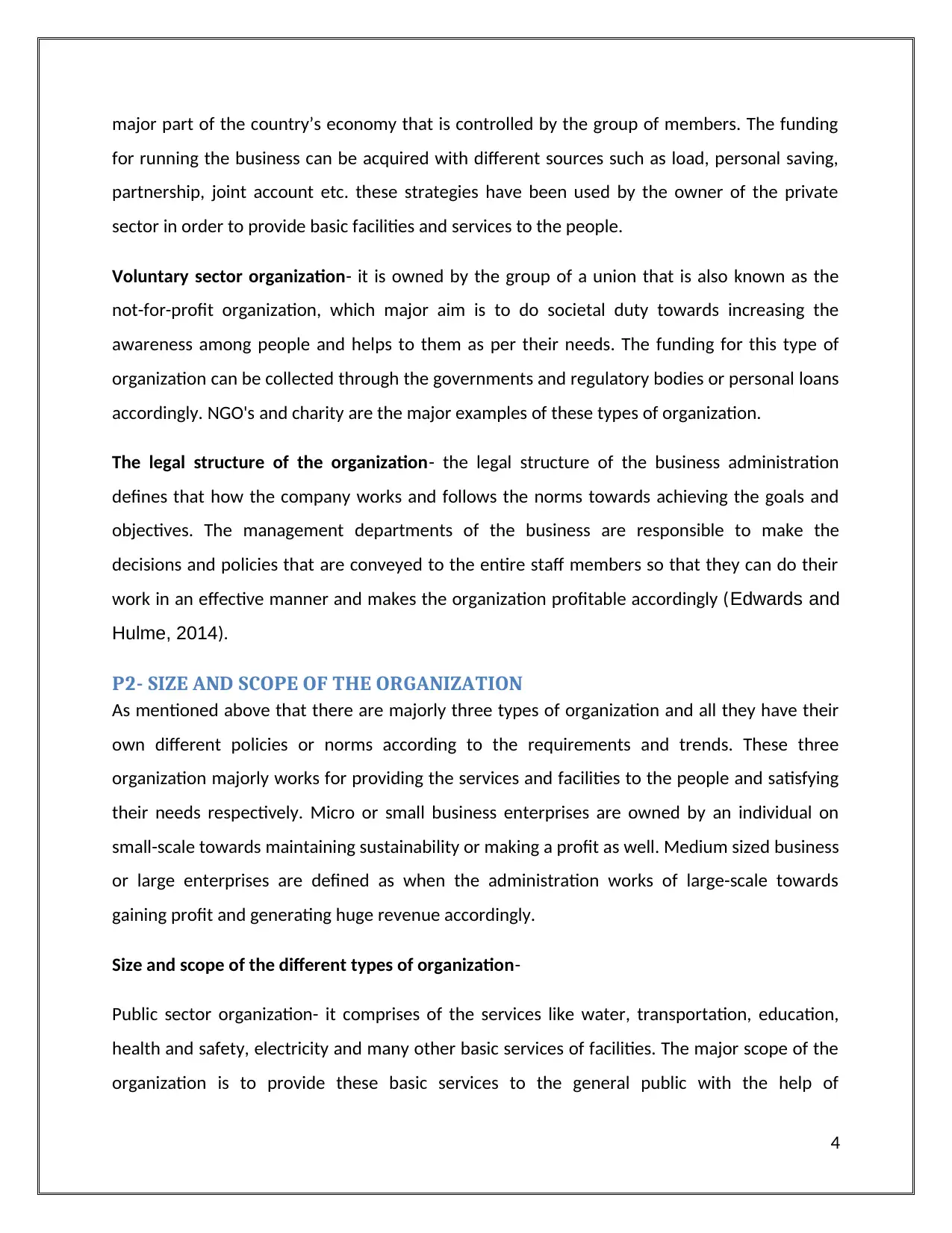
major part of the country’s economy that is controlled by the group of members. The funding
for running the business can be acquired with different sources such as load, personal saving,
partnership, joint account etc. these strategies have been used by the owner of the private
sector in order to provide basic facilities and services to the people.
Voluntary sector organization- it is owned by the group of a union that is also known as the
not-for-profit organization, which major aim is to do societal duty towards increasing the
awareness among people and helps to them as per their needs. The funding for this type of
organization can be collected through the governments and regulatory bodies or personal loans
accordingly. NGO's and charity are the major examples of these types of organization.
The legal structure of the organization- the legal structure of the business administration
defines that how the company works and follows the norms towards achieving the goals and
objectives. The management departments of the business are responsible to make the
decisions and policies that are conveyed to the entire staff members so that they can do their
work in an effective manner and makes the organization profitable accordingly (Edwards and
Hulme, 2014).
P2- SIZE AND SCOPE OF THE ORGANIZATION
As mentioned above that there are majorly three types of organization and all they have their
own different policies or norms according to the requirements and trends. These three
organization majorly works for providing the services and facilities to the people and satisfying
their needs respectively. Micro or small business enterprises are owned by an individual on
small-scale towards maintaining sustainability or making a profit as well. Medium sized business
or large enterprises are defined as when the administration works of large-scale towards
gaining profit and generating huge revenue accordingly.
Size and scope of the different types of organization-
Public sector organization- it comprises of the services like water, transportation, education,
health and safety, electricity and many other basic services of facilities. The major scope of the
organization is to provide these basic services to the general public with the help of
4
for running the business can be acquired with different sources such as load, personal saving,
partnership, joint account etc. these strategies have been used by the owner of the private
sector in order to provide basic facilities and services to the people.
Voluntary sector organization- it is owned by the group of a union that is also known as the
not-for-profit organization, which major aim is to do societal duty towards increasing the
awareness among people and helps to them as per their needs. The funding for this type of
organization can be collected through the governments and regulatory bodies or personal loans
accordingly. NGO's and charity are the major examples of these types of organization.
The legal structure of the organization- the legal structure of the business administration
defines that how the company works and follows the norms towards achieving the goals and
objectives. The management departments of the business are responsible to make the
decisions and policies that are conveyed to the entire staff members so that they can do their
work in an effective manner and makes the organization profitable accordingly (Edwards and
Hulme, 2014).
P2- SIZE AND SCOPE OF THE ORGANIZATION
As mentioned above that there are majorly three types of organization and all they have their
own different policies or norms according to the requirements and trends. These three
organization majorly works for providing the services and facilities to the people and satisfying
their needs respectively. Micro or small business enterprises are owned by an individual on
small-scale towards maintaining sustainability or making a profit as well. Medium sized business
or large enterprises are defined as when the administration works of large-scale towards
gaining profit and generating huge revenue accordingly.
Size and scope of the different types of organization-
Public sector organization- it comprises of the services like water, transportation, education,
health and safety, electricity and many other basic services of facilities. The major scope of the
organization is to provide these basic services to the general public with the help of
4
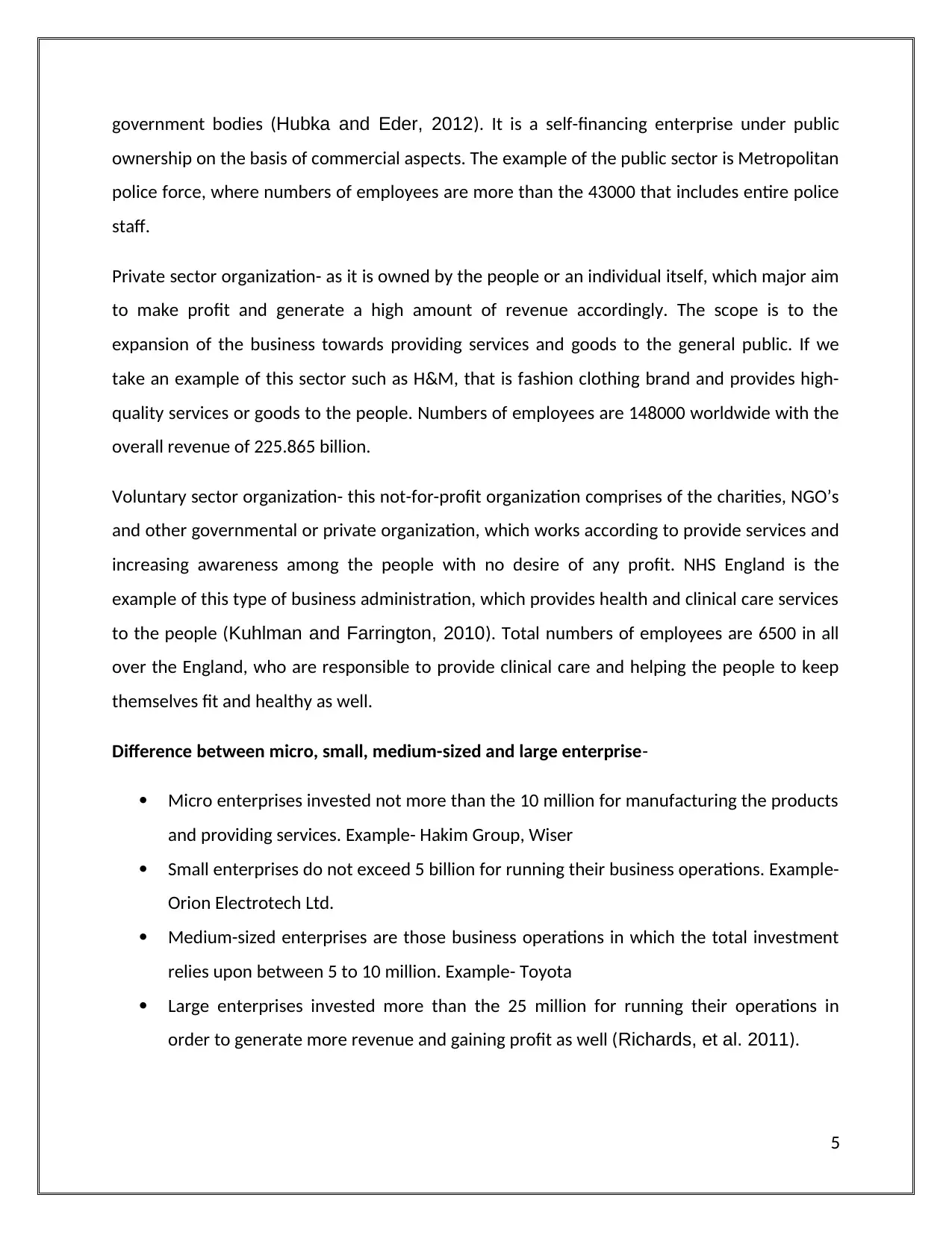
government bodies (Hubka and Eder, 2012). It is a self-financing enterprise under public
ownership on the basis of commercial aspects. The example of the public sector is Metropolitan
police force, where numbers of employees are more than the 43000 that includes entire police
staff.
Private sector organization- as it is owned by the people or an individual itself, which major aim
to make profit and generate a high amount of revenue accordingly. The scope is to the
expansion of the business towards providing services and goods to the general public. If we
take an example of this sector such as H&M, that is fashion clothing brand and provides high-
quality services or goods to the people. Numbers of employees are 148000 worldwide with the
overall revenue of 225.865 billion.
Voluntary sector organization- this not-for-profit organization comprises of the charities, NGO’s
and other governmental or private organization, which works according to provide services and
increasing awareness among the people with no desire of any profit. NHS England is the
example of this type of business administration, which provides health and clinical care services
to the people (Kuhlman and Farrington, 2010). Total numbers of employees are 6500 in all
over the England, who are responsible to provide clinical care and helping the people to keep
themselves fit and healthy as well.
Difference between micro, small, medium-sized and large enterprise-
Micro enterprises invested not more than the 10 million for manufacturing the products
and providing services. Example- Hakim Group, Wiser
Small enterprises do not exceed 5 billion for running their business operations. Example-
Orion Electrotech Ltd.
Medium-sized enterprises are those business operations in which the total investment
relies upon between 5 to 10 million. Example- Toyota
Large enterprises invested more than the 25 million for running their operations in
order to generate more revenue and gaining profit as well (Richards, et al. 2011).
5
ownership on the basis of commercial aspects. The example of the public sector is Metropolitan
police force, where numbers of employees are more than the 43000 that includes entire police
staff.
Private sector organization- as it is owned by the people or an individual itself, which major aim
to make profit and generate a high amount of revenue accordingly. The scope is to the
expansion of the business towards providing services and goods to the general public. If we
take an example of this sector such as H&M, that is fashion clothing brand and provides high-
quality services or goods to the people. Numbers of employees are 148000 worldwide with the
overall revenue of 225.865 billion.
Voluntary sector organization- this not-for-profit organization comprises of the charities, NGO’s
and other governmental or private organization, which works according to provide services and
increasing awareness among the people with no desire of any profit. NHS England is the
example of this type of business administration, which provides health and clinical care services
to the people (Kuhlman and Farrington, 2010). Total numbers of employees are 6500 in all
over the England, who are responsible to provide clinical care and helping the people to keep
themselves fit and healthy as well.
Difference between micro, small, medium-sized and large enterprise-
Micro enterprises invested not more than the 10 million for manufacturing the products
and providing services. Example- Hakim Group, Wiser
Small enterprises do not exceed 5 billion for running their business operations. Example-
Orion Electrotech Ltd.
Medium-sized enterprises are those business operations in which the total investment
relies upon between 5 to 10 million. Example- Toyota
Large enterprises invested more than the 25 million for running their operations in
order to generate more revenue and gaining profit as well (Richards, et al. 2011).
5
⊘ This is a preview!⊘
Do you want full access?
Subscribe today to unlock all pages.

Trusted by 1+ million students worldwide
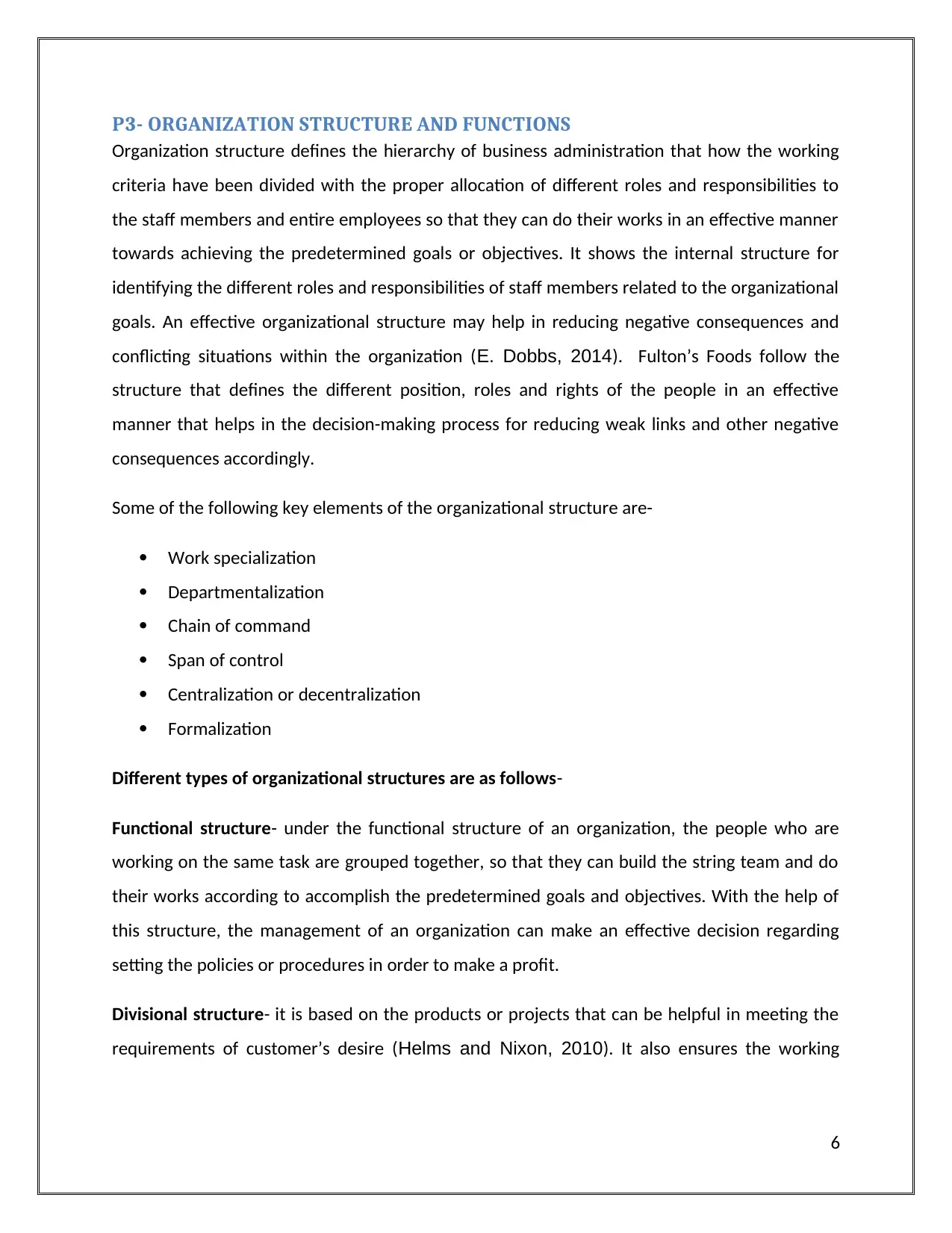
P3- ORGANIZATION STRUCTURE AND FUNCTIONS
Organization structure defines the hierarchy of business administration that how the working
criteria have been divided with the proper allocation of different roles and responsibilities to
the staff members and entire employees so that they can do their works in an effective manner
towards achieving the predetermined goals or objectives. It shows the internal structure for
identifying the different roles and responsibilities of staff members related to the organizational
goals. An effective organizational structure may help in reducing negative consequences and
conflicting situations within the organization (E. Dobbs, 2014). Fulton’s Foods follow the
structure that defines the different position, roles and rights of the people in an effective
manner that helps in the decision-making process for reducing weak links and other negative
consequences accordingly.
Some of the following key elements of the organizational structure are-
Work specialization
Departmentalization
Chain of command
Span of control
Centralization or decentralization
Formalization
Different types of organizational structures are as follows-
Functional structure- under the functional structure of an organization, the people who are
working on the same task are grouped together, so that they can build the string team and do
their works according to accomplish the predetermined goals and objectives. With the help of
this structure, the management of an organization can make an effective decision regarding
setting the policies or procedures in order to make a profit.
Divisional structure- it is based on the products or projects that can be helpful in meeting the
requirements of customer’s desire (Helms and Nixon, 2010). It also ensures the working
6
Organization structure defines the hierarchy of business administration that how the working
criteria have been divided with the proper allocation of different roles and responsibilities to
the staff members and entire employees so that they can do their works in an effective manner
towards achieving the predetermined goals or objectives. It shows the internal structure for
identifying the different roles and responsibilities of staff members related to the organizational
goals. An effective organizational structure may help in reducing negative consequences and
conflicting situations within the organization (E. Dobbs, 2014). Fulton’s Foods follow the
structure that defines the different position, roles and rights of the people in an effective
manner that helps in the decision-making process for reducing weak links and other negative
consequences accordingly.
Some of the following key elements of the organizational structure are-
Work specialization
Departmentalization
Chain of command
Span of control
Centralization or decentralization
Formalization
Different types of organizational structures are as follows-
Functional structure- under the functional structure of an organization, the people who are
working on the same task are grouped together, so that they can build the string team and do
their works according to accomplish the predetermined goals and objectives. With the help of
this structure, the management of an organization can make an effective decision regarding
setting the policies or procedures in order to make a profit.
Divisional structure- it is based on the products or projects that can be helpful in meeting the
requirements of customer’s desire (Helms and Nixon, 2010). It also ensures the working
6
Paraphrase This Document
Need a fresh take? Get an instant paraphrase of this document with our AI Paraphraser
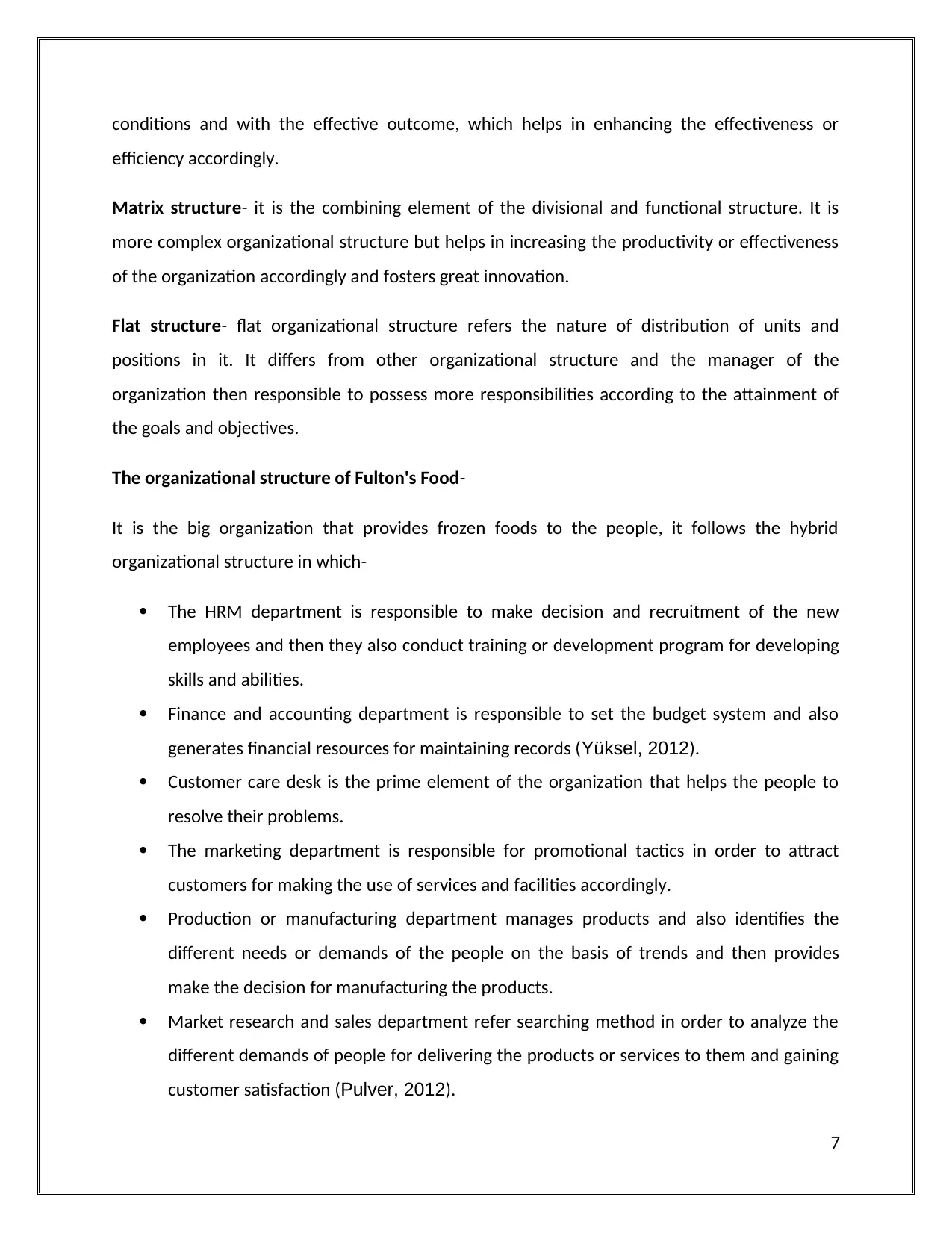
conditions and with the effective outcome, which helps in enhancing the effectiveness or
efficiency accordingly.
Matrix structure- it is the combining element of the divisional and functional structure. It is
more complex organizational structure but helps in increasing the productivity or effectiveness
of the organization accordingly and fosters great innovation.
Flat structure- flat organizational structure refers the nature of distribution of units and
positions in it. It differs from other organizational structure and the manager of the
organization then responsible to possess more responsibilities according to the attainment of
the goals and objectives.
The organizational structure of Fulton's Food-
It is the big organization that provides frozen foods to the people, it follows the hybrid
organizational structure in which-
The HRM department is responsible to make decision and recruitment of the new
employees and then they also conduct training or development program for developing
skills and abilities.
Finance and accounting department is responsible to set the budget system and also
generates financial resources for maintaining records (Yüksel, 2012).
Customer care desk is the prime element of the organization that helps the people to
resolve their problems.
The marketing department is responsible for promotional tactics in order to attract
customers for making the use of services and facilities accordingly.
Production or manufacturing department manages products and also identifies the
different needs or demands of the people on the basis of trends and then provides
make the decision for manufacturing the products.
Market research and sales department refer searching method in order to analyze the
different demands of people for delivering the products or services to them and gaining
customer satisfaction (Pulver, 2012).
7
efficiency accordingly.
Matrix structure- it is the combining element of the divisional and functional structure. It is
more complex organizational structure but helps in increasing the productivity or effectiveness
of the organization accordingly and fosters great innovation.
Flat structure- flat organizational structure refers the nature of distribution of units and
positions in it. It differs from other organizational structure and the manager of the
organization then responsible to possess more responsibilities according to the attainment of
the goals and objectives.
The organizational structure of Fulton's Food-
It is the big organization that provides frozen foods to the people, it follows the hybrid
organizational structure in which-
The HRM department is responsible to make decision and recruitment of the new
employees and then they also conduct training or development program for developing
skills and abilities.
Finance and accounting department is responsible to set the budget system and also
generates financial resources for maintaining records (Yüksel, 2012).
Customer care desk is the prime element of the organization that helps the people to
resolve their problems.
The marketing department is responsible for promotional tactics in order to attract
customers for making the use of services and facilities accordingly.
Production or manufacturing department manages products and also identifies the
different needs or demands of the people on the basis of trends and then provides
make the decision for manufacturing the products.
Market research and sales department refer searching method in order to analyze the
different demands of people for delivering the products or services to them and gaining
customer satisfaction (Pulver, 2012).
7
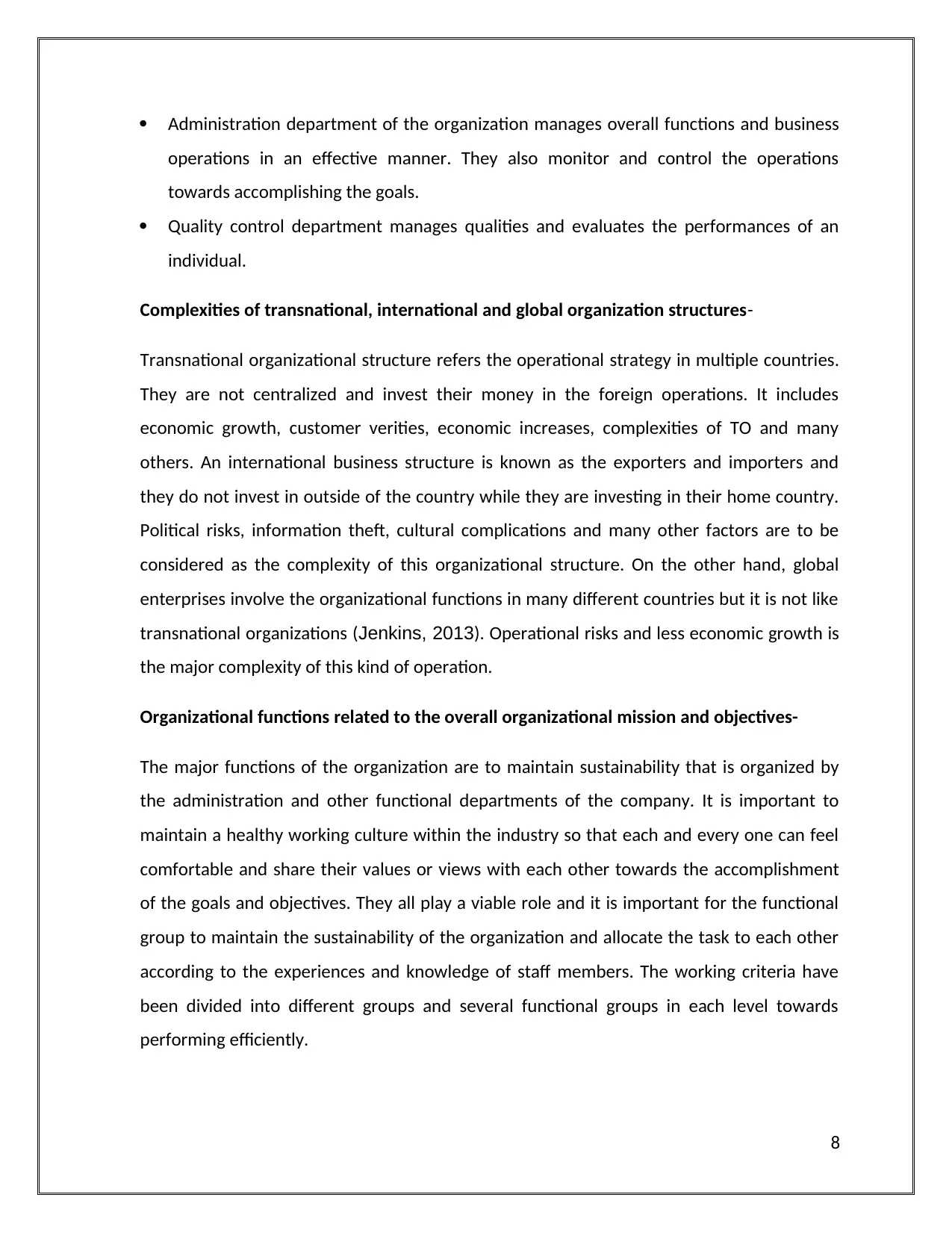
Administration department of the organization manages overall functions and business
operations in an effective manner. They also monitor and control the operations
towards accomplishing the goals.
Quality control department manages qualities and evaluates the performances of an
individual.
Complexities of transnational, international and global organization structures-
Transnational organizational structure refers the operational strategy in multiple countries.
They are not centralized and invest their money in the foreign operations. It includes
economic growth, customer verities, economic increases, complexities of TO and many
others. An international business structure is known as the exporters and importers and
they do not invest in outside of the country while they are investing in their home country.
Political risks, information theft, cultural complications and many other factors are to be
considered as the complexity of this organizational structure. On the other hand, global
enterprises involve the organizational functions in many different countries but it is not like
transnational organizations (Jenkins, 2013). Operational risks and less economic growth is
the major complexity of this kind of operation.
Organizational functions related to the overall organizational mission and objectives-
The major functions of the organization are to maintain sustainability that is organized by
the administration and other functional departments of the company. It is important to
maintain a healthy working culture within the industry so that each and every one can feel
comfortable and share their values or views with each other towards the accomplishment
of the goals and objectives. They all play a viable role and it is important for the functional
group to maintain the sustainability of the organization and allocate the task to each other
according to the experiences and knowledge of staff members. The working criteria have
been divided into different groups and several functional groups in each level towards
performing efficiently.
8
operations in an effective manner. They also monitor and control the operations
towards accomplishing the goals.
Quality control department manages qualities and evaluates the performances of an
individual.
Complexities of transnational, international and global organization structures-
Transnational organizational structure refers the operational strategy in multiple countries.
They are not centralized and invest their money in the foreign operations. It includes
economic growth, customer verities, economic increases, complexities of TO and many
others. An international business structure is known as the exporters and importers and
they do not invest in outside of the country while they are investing in their home country.
Political risks, information theft, cultural complications and many other factors are to be
considered as the complexity of this organizational structure. On the other hand, global
enterprises involve the organizational functions in many different countries but it is not like
transnational organizations (Jenkins, 2013). Operational risks and less economic growth is
the major complexity of this kind of operation.
Organizational functions related to the overall organizational mission and objectives-
The major functions of the organization are to maintain sustainability that is organized by
the administration and other functional departments of the company. It is important to
maintain a healthy working culture within the industry so that each and every one can feel
comfortable and share their values or views with each other towards the accomplishment
of the goals and objectives. They all play a viable role and it is important for the functional
group to maintain the sustainability of the organization and allocate the task to each other
according to the experiences and knowledge of staff members. The working criteria have
been divided into different groups and several functional groups in each level towards
performing efficiently.
8
⊘ This is a preview!⊘
Do you want full access?
Subscribe today to unlock all pages.

Trusted by 1+ million students worldwide
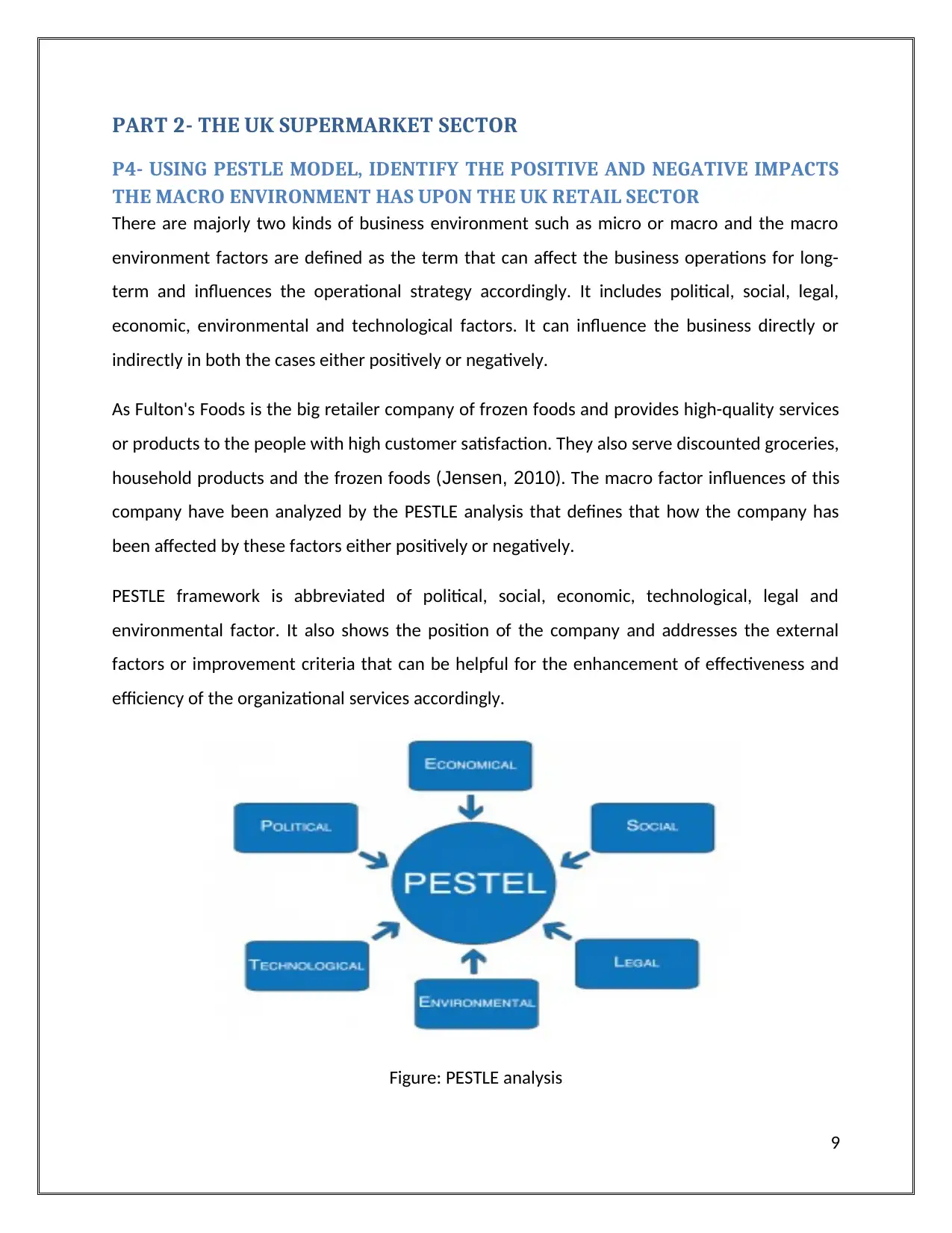
PART 2- THE UK SUPERMARKET SECTOR
P4- USING PESTLE MODEL, IDENTIFY THE POSITIVE AND NEGATIVE IMPACTS
THE MACRO ENVIRONMENT HAS UPON THE UK RETAIL SECTOR
There are majorly two kinds of business environment such as micro or macro and the macro
environment factors are defined as the term that can affect the business operations for long-
term and influences the operational strategy accordingly. It includes political, social, legal,
economic, environmental and technological factors. It can influence the business directly or
indirectly in both the cases either positively or negatively.
As Fulton's Foods is the big retailer company of frozen foods and provides high-quality services
or products to the people with high customer satisfaction. They also serve discounted groceries,
household products and the frozen foods (Jensen, 2010). The macro factor influences of this
company have been analyzed by the PESTLE analysis that defines that how the company has
been affected by these factors either positively or negatively.
PESTLE framework is abbreviated of political, social, economic, technological, legal and
environmental factor. It also shows the position of the company and addresses the external
factors or improvement criteria that can be helpful for the enhancement of effectiveness and
efficiency of the organizational services accordingly.
Figure: PESTLE analysis
9
P4- USING PESTLE MODEL, IDENTIFY THE POSITIVE AND NEGATIVE IMPACTS
THE MACRO ENVIRONMENT HAS UPON THE UK RETAIL SECTOR
There are majorly two kinds of business environment such as micro or macro and the macro
environment factors are defined as the term that can affect the business operations for long-
term and influences the operational strategy accordingly. It includes political, social, legal,
economic, environmental and technological factors. It can influence the business directly or
indirectly in both the cases either positively or negatively.
As Fulton's Foods is the big retailer company of frozen foods and provides high-quality services
or products to the people with high customer satisfaction. They also serve discounted groceries,
household products and the frozen foods (Jensen, 2010). The macro factor influences of this
company have been analyzed by the PESTLE analysis that defines that how the company has
been affected by these factors either positively or negatively.
PESTLE framework is abbreviated of political, social, economic, technological, legal and
environmental factor. It also shows the position of the company and addresses the external
factors or improvement criteria that can be helpful for the enhancement of effectiveness and
efficiency of the organizational services accordingly.
Figure: PESTLE analysis
9
Paraphrase This Document
Need a fresh take? Get an instant paraphrase of this document with our AI Paraphraser
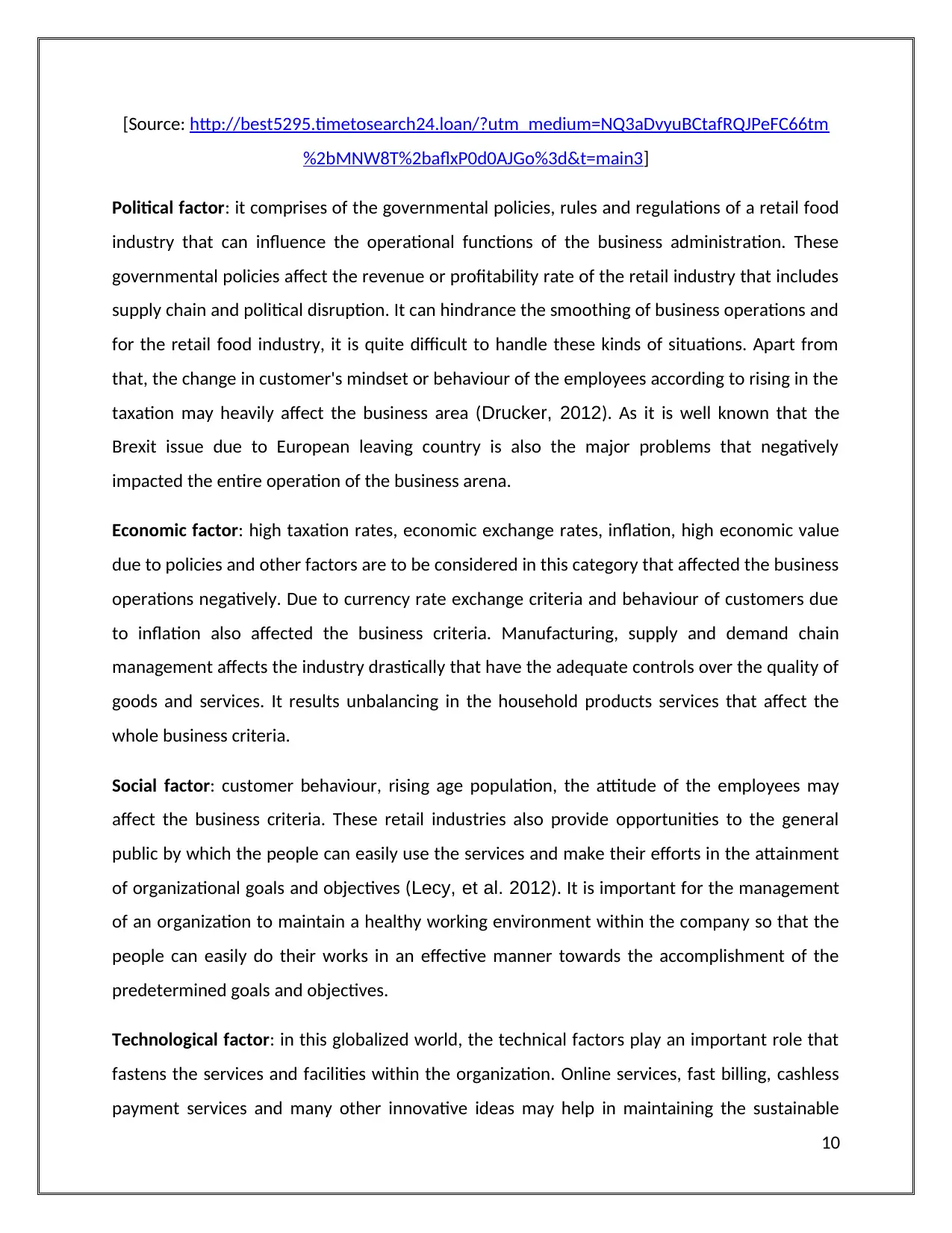
[Source: http://best5295.timetosearch24.loan/?utm_medium=NQ3aDvyuBCtafRQJPeFC66tm
%2bMNW8T%2baflxP0d0AJGo%3d&t=main3]
Political factor: it comprises of the governmental policies, rules and regulations of a retail food
industry that can influence the operational functions of the business administration. These
governmental policies affect the revenue or profitability rate of the retail industry that includes
supply chain and political disruption. It can hindrance the smoothing of business operations and
for the retail food industry, it is quite difficult to handle these kinds of situations. Apart from
that, the change in customer's mindset or behaviour of the employees according to rising in the
taxation may heavily affect the business area (Drucker, 2012). As it is well known that the
Brexit issue due to European leaving country is also the major problems that negatively
impacted the entire operation of the business arena.
Economic factor: high taxation rates, economic exchange rates, inflation, high economic value
due to policies and other factors are to be considered in this category that affected the business
operations negatively. Due to currency rate exchange criteria and behaviour of customers due
to inflation also affected the business criteria. Manufacturing, supply and demand chain
management affects the industry drastically that have the adequate controls over the quality of
goods and services. It results unbalancing in the household products services that affect the
whole business criteria.
Social factor: customer behaviour, rising age population, the attitude of the employees may
affect the business criteria. These retail industries also provide opportunities to the general
public by which the people can easily use the services and make their efforts in the attainment
of organizational goals and objectives (Lecy, et al. 2012). It is important for the management
of an organization to maintain a healthy working environment within the company so that the
people can easily do their works in an effective manner towards the accomplishment of the
predetermined goals and objectives.
Technological factor: in this globalized world, the technical factors play an important role that
fastens the services and facilities within the organization. Online services, fast billing, cashless
payment services and many other innovative ideas may help in maintaining the sustainable
10
%2bMNW8T%2baflxP0d0AJGo%3d&t=main3]
Political factor: it comprises of the governmental policies, rules and regulations of a retail food
industry that can influence the operational functions of the business administration. These
governmental policies affect the revenue or profitability rate of the retail industry that includes
supply chain and political disruption. It can hindrance the smoothing of business operations and
for the retail food industry, it is quite difficult to handle these kinds of situations. Apart from
that, the change in customer's mindset or behaviour of the employees according to rising in the
taxation may heavily affect the business area (Drucker, 2012). As it is well known that the
Brexit issue due to European leaving country is also the major problems that negatively
impacted the entire operation of the business arena.
Economic factor: high taxation rates, economic exchange rates, inflation, high economic value
due to policies and other factors are to be considered in this category that affected the business
operations negatively. Due to currency rate exchange criteria and behaviour of customers due
to inflation also affected the business criteria. Manufacturing, supply and demand chain
management affects the industry drastically that have the adequate controls over the quality of
goods and services. It results unbalancing in the household products services that affect the
whole business criteria.
Social factor: customer behaviour, rising age population, the attitude of the employees may
affect the business criteria. These retail industries also provide opportunities to the general
public by which the people can easily use the services and make their efforts in the attainment
of organizational goals and objectives (Lecy, et al. 2012). It is important for the management
of an organization to maintain a healthy working environment within the company so that the
people can easily do their works in an effective manner towards the accomplishment of the
predetermined goals and objectives.
Technological factor: in this globalized world, the technical factors play an important role that
fastens the services and facilities within the organization. Online services, fast billing, cashless
payment services and many other innovative ideas may help in maintaining the sustainable
10
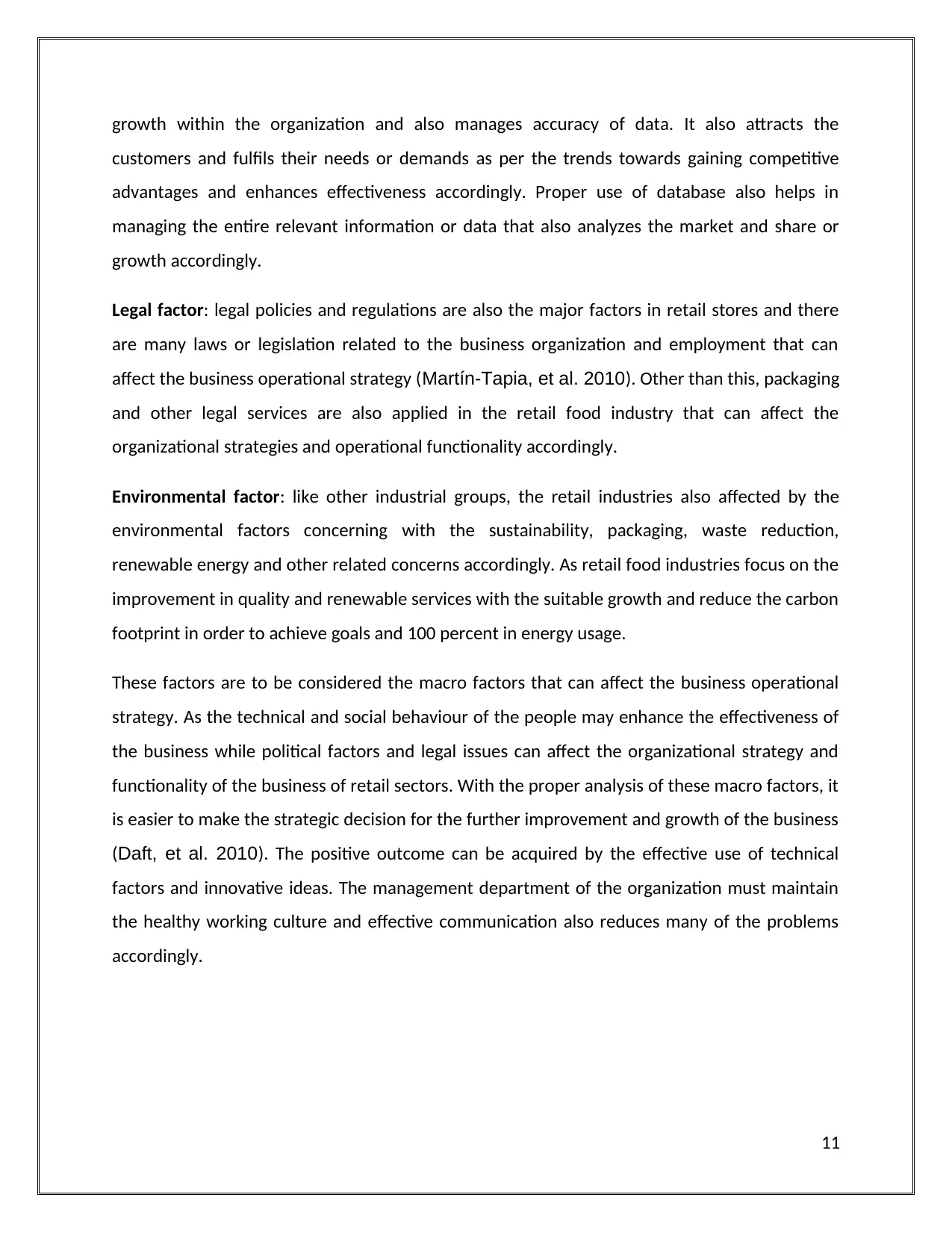
growth within the organization and also manages accuracy of data. It also attracts the
customers and fulfils their needs or demands as per the trends towards gaining competitive
advantages and enhances effectiveness accordingly. Proper use of database also helps in
managing the entire relevant information or data that also analyzes the market and share or
growth accordingly.
Legal factor: legal policies and regulations are also the major factors in retail stores and there
are many laws or legislation related to the business organization and employment that can
affect the business operational strategy (Martín-Tapia, et al. 2010). Other than this, packaging
and other legal services are also applied in the retail food industry that can affect the
organizational strategies and operational functionality accordingly.
Environmental factor: like other industrial groups, the retail industries also affected by the
environmental factors concerning with the sustainability, packaging, waste reduction,
renewable energy and other related concerns accordingly. As retail food industries focus on the
improvement in quality and renewable services with the suitable growth and reduce the carbon
footprint in order to achieve goals and 100 percent in energy usage.
These factors are to be considered the macro factors that can affect the business operational
strategy. As the technical and social behaviour of the people may enhance the effectiveness of
the business while political factors and legal issues can affect the organizational strategy and
functionality of the business of retail sectors. With the proper analysis of these macro factors, it
is easier to make the strategic decision for the further improvement and growth of the business
(Daft, et al. 2010). The positive outcome can be acquired by the effective use of technical
factors and innovative ideas. The management department of the organization must maintain
the healthy working culture and effective communication also reduces many of the problems
accordingly.
11
customers and fulfils their needs or demands as per the trends towards gaining competitive
advantages and enhances effectiveness accordingly. Proper use of database also helps in
managing the entire relevant information or data that also analyzes the market and share or
growth accordingly.
Legal factor: legal policies and regulations are also the major factors in retail stores and there
are many laws or legislation related to the business organization and employment that can
affect the business operational strategy (Martín-Tapia, et al. 2010). Other than this, packaging
and other legal services are also applied in the retail food industry that can affect the
organizational strategies and operational functionality accordingly.
Environmental factor: like other industrial groups, the retail industries also affected by the
environmental factors concerning with the sustainability, packaging, waste reduction,
renewable energy and other related concerns accordingly. As retail food industries focus on the
improvement in quality and renewable services with the suitable growth and reduce the carbon
footprint in order to achieve goals and 100 percent in energy usage.
These factors are to be considered the macro factors that can affect the business operational
strategy. As the technical and social behaviour of the people may enhance the effectiveness of
the business while political factors and legal issues can affect the organizational strategy and
functionality of the business of retail sectors. With the proper analysis of these macro factors, it
is easier to make the strategic decision for the further improvement and growth of the business
(Daft, et al. 2010). The positive outcome can be acquired by the effective use of technical
factors and innovative ideas. The management department of the organization must maintain
the healthy working culture and effective communication also reduces many of the problems
accordingly.
11
⊘ This is a preview!⊘
Do you want full access?
Subscribe today to unlock all pages.

Trusted by 1+ million students worldwide
1 out of 20
Related Documents
Your All-in-One AI-Powered Toolkit for Academic Success.
+13062052269
info@desklib.com
Available 24*7 on WhatsApp / Email
![[object Object]](/_next/static/media/star-bottom.7253800d.svg)
Unlock your academic potential
Copyright © 2020–2025 A2Z Services. All Rights Reserved. Developed and managed by ZUCOL.



